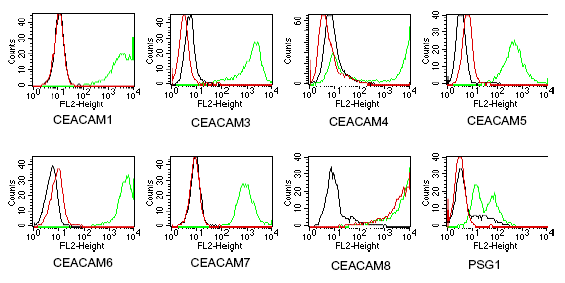Product Details
| Alternative Name: | Carcinoembryonic antigen-related cell adhesion molecule 8, CD66b |
| |
| Clone: | GM2H6 |
| |
| Host: | Mouse |
| |
| Isotype: | IgG1 |
| |
| Immunogen: | Vector containing the cDNA of human CEACAM8. |
| |
| UniProt ID: | P31997 |
| |
| Species reactivity: | Human
|
| |
| Crossreactivity: | Does not cross-react with human CEACAM1, 3, 4, 5, 6, 7, or PSG1. |
| |
| Applications: | ELISA, Flow Cytometry
|
| |
| Recommended Dilutions/Conditions: | Competitive ELISA (1.2µg/106 cells)
Flow Cytometry (1:200-1:400)
Suggested dilutions/conditions may not be available for all applications.
Optimal conditions must be determined individually for each application. |
| |
| Purity Detail: | Protein G-affinity purified. |
| |
| Quality Control: | Specificity routinely tested by flow cytometry on CEACAM8 transfected BOSC23 cells. |
| |
| Formulation: | Liquid. In PBS, pH 7.2. Contains no preservatives. |
| |
| Handling: | For maximum product recovery after thawing, centrifuge the vial before opening the cap. Avoid freeze/thaw cycles. |
| |
| Shipping: | Blue Ice |
| |
| Short Term Storage: | +4°C |
| |
| Long Term Storage: | -20°C |
| |
| Scientific Background: | CEA-related cell adhesion molecule 8 (CEACAM8) belongs to the carcinoembryonic antigen (CEA) gene family. It encodes a glycosylphosphatidylinositol (GPI)-linked glycoprotein with a molecular mass of of 95kD and is expressed in cells of the granulocyte-lineage. It is expressed in neutrophils and eosinophils and is characterized as a granulocyte-specific activation antigen. Therefore CEACAM8 could serve as a marker for granulocyte activities. Like all members of the CEA family, it consists of a single N domain, with structural homology to the immunoglobulin variable domains, followed by two immunoglobulin constant-like A and B domains. |
| |
| Regulatory Status: | RUO - Research Use Only |
| |

Figure 1: Specificity testing by flow cytometry.Method: FACS analysis of BOSC23 cells using CEACAM8 (human), mAb (GM2H6) (Prod. No. ALX- 805-088). BOSC23 cells were transiently transfected with an expression vector encoding either CEACAM8 (red curve) or an irrelevant protein (control transfectant). Binding of CEACAM8 (human), mAb (GM2H6) was detected with a PE conjugated secondary antibody. A positive signal was obtained only with CEACAM8 transfected cells.

Figure 2: Antibody cross-reactivity with members of the CEA family.Method: BOSC23 cells were transiently transfected with expression vectors containing either the cDNA of CEACAM1, CEACAM3-8 or PSG. The latter expressed as a membrane bound fusion protein. Expression of the constructs was tested with monoclonal antibodies known to recognize the corresponding proteins (green curves). An irrelevant monoclonal antibody served asa negative control (black curves). For specificity testing, CEACAM8 (human), mAb (GM2H6) (Prod. No. ALX- 805-088) was tested on all CEACAM transfectants. A positive signal was obtained only with CEACAM8 transfected cells (red curve).
Please mouse over
General Literature References
Carcinoembryonic antigen: W. Zimmermann; Wiley Encyclopedia of Molecular Medicine (T. Creighton, ed.), John Wiley & Sons Inc., New York 459 (2002),
The carcinoembryonic antigen (CEA) family: structures, suggested functions and expression in normal and malignant tissues: S. Hammarström; Semin. Cancer Biol.
9, 67 (1999), (Review),
Abstract;












